THE BEGINNINGS OF THE FLYNNS
Once upon a time, there was a tribe of Gaels descended from CONN THE HUNDRED-FIGHTER and so known as the Connachta. The Connachta grew fruitful and multiplied and divided into the Ui Briuin, Ui Fiachrach, and other tribes; and the Ui Briuin subsequently split into the Ui Briuin Ai on the plain of Mag nAi, the Ui Briuin Breifne (O Rourke, O Reilly, etc.) and the Ui Briuin Seola (O Flaherty, etc.). The Ui Briuin Ai, in turn, diversified into the Sil Maelruain (O Flynn, etc.), the Sil Muiredaigh (McGeraghty, O Connor, etc.) and the Sil Cathail (O Flannigan, etc.)
AD 554. CURNAN, the son of Aedh Abraidh, 8th Christian king of Connacht, went to St. Columcille for protection from the High King, Dermot son of Cearbhail; but Dermot's soldiers ignored the guarantee of sanctuary and forcibly took Curnan from Columcille and killed him, "which was the cause of the Battle of Cul-Dreimhne." Columcille went to his relatives, the O Neill of the North, who allied with the king of Connaught to defeat the High King. It is from Curnan that the O'Flynns trace their descent.
Curnan gave his name to the TELLACH CURNAN, a district which in medieval times included the Monastery of Boyle and the church of St. Dachona at Assylin (Ess ua Fhlainn, or O Flynn's Cataract, a/k/a Eas-mic n-Eirc). St. Dachona was the special saint of the clan.
The aboriginal inhabitants of the region lived in ring forts in Kiltullagh and Granlahan. One of the chiefs, Enda, was converted by St. Patrick, and gave land to the saint for the building of a church on Cill Tulach (Kiltullagh, the name of the village, and the name of the modern-day parish.) These may have been ancestors of the O'Flynns or they may have been the earlier Pictish folk known as the Conmaicne (Conway).
The Tribe of the Sil Maelruain
AD 1046. The Ui Briuin defeated the Conmaicne (Conway) at the Battle of O Flynn's Mountain. It was at this time that the UI FHLAINN came into their rightful inheritance, seizing it from the Conway tribes who has inexplicably occupied the land previously. Part of the tribal confederacy was the SIL MAELRUAIN, "Seed of Mulrooney," named after Curnan's son, MAELRUAIN.
The leader of the Sil Maelruain seems to have been one FLANN son of Donall.
O Hart's Irish Pedigrees
gives nine generations between Curnan and Flann and that is not nearly
enough to fill 500 years! Likely, the family traditions on which O'Hart
based his work were a trifle sketchy that far back.
And Flann begat Fothach, who begat FEACH. O'Hart says that he was the first to use the Name of O'Flainn (which we now spell O'Flynn). Perhaps it was FEACH O'FLYNN who led the Sil Maelruain into their medieval territories. It was around this time that tribes were taking on family names all across Ireland.
And Flann begat Fothach, who begat FEACH. O'Hart says that he was the first to use the Name of O'Flainn (which we now spell O'Flynn). Perhaps it was FEACH O'FLYNN who led the Sil Maelruain into their medieval territories. It was around this time that tribes were taking on family names all across Ireland.
A WORD ABOUT O'FLOINN. O'Flainn meant "descendent of Flann" and Flann meant "ruddy complexioned." Many Irish names were based on physical attributes. But since the Gaels were a red-headed race, the name Flann popped up spontaneously in many places and it turns out that when family names were being adopted there were at least three clans with famous Flanns in their ancestry. The other Flynn clans are unrelated to the Flynns of the West, however. Due to a difference in accent, the Flynns of the North are now called O'Lynn. There were also Flynns in the South, in Munster.
For such a simple, one syllable name, you would think no one would screw it up. But spelling was not standardized, and the name has been variously rendered in the records, even in the Gaelic. In the Annals of the Four Masters, the Annals of Connaught, and the Annals of Lough Ce, one favors O'Floinn and another uses O'Flainn. The explanation is simple: the broad vowel "o" or "a" is simply a placeholder to prevent the slender vowel "i" from wreaking havoc with the poor unfortunate consonant "l". This was an Irish spelling convention and it worked the other way, too. A slender "i" or "e" might be inserted to protect a consonant from being affected by a broad vowel. Thus, both O'Floinn and O'Flainn would be pronounced simply O'Flinn. It is unclear when the Greek-i -- "y" or ypsilon -- came into use, certainly before the 1600s. In various documents the Name has been spelled every which way - Flynn, Flyn, Flin, Fflenn, and Fflinn, with two f's, with and without capitalization, with and without the O! It has even been spelled Fling, Flynge and the like, which may give a hint of what that slender i was capable of doing to a poor innocent n. In any case, to avoid confusion, I have mostly used the modern spelling here.
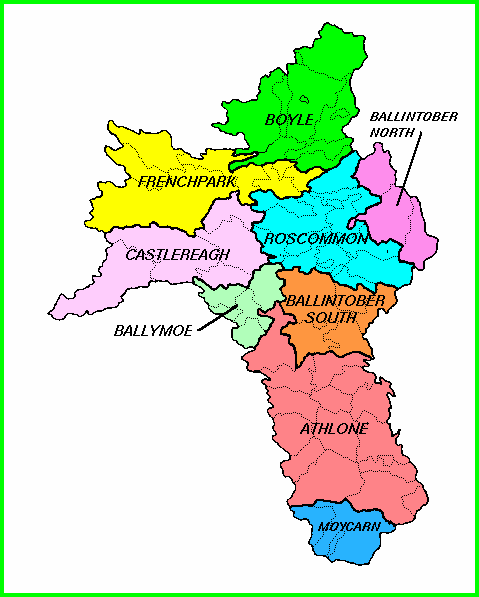 |
| The Flynn lands were in the two parishes dotted out in the "beak" of Castlereagh, and included some Galway land to the south, down to about where the arrow is for Ballymoe. |
The
Sil Maelruain, under their O'Flynn chieftains, occupied the land around
the town of Ballinlough in the "parrot's beak" region of western Co.
Roscommon. It lies about halfway between the towns of Castlereagh and Ballyhaunis (Mayo) and is very near the Mayo county border. The clan territory consisted of the present day parishes of Kiltullagh
and Kilkeevin in County Roscommon plus a large portion of Ballinakill in
Co. Galway, down to the bridge at Glinsk, the whole comprising about
25,000 acres. It included the mountainous district
of Sliabh O'Floinn or O'Flynn's Mountain just above
Ballinlough itself. At the base of the mountain is Lough O'Floinn, or
O'Flynn's Lake. It is the greater part of the present Barony of Castlereagh. plus adjacent areas in Galway.
The land was heavily wooded in the Middle Ages and has returned to that state today. Lough O'Flynn is touted as a fishing, boating, hiking destination. Lough O'Flynn is the source of the River Suck, and TOF will pause here for the usual sophisticated humor.
The O Flynns were border lords of the O'Connor kingdom against the O Kelly's and others. Their neighbors guarding the south west borderlands were the MacBrennans. Presumably, since the O'Flynn held the Sil Maelruain and the Tellach Curnan, the original patrimony probably included the Plain of Ai (Mag nAi) which lies between them in modern Frenchpark Barony, but this area was later settled by McDermots.
BALLINLOUGH means "Town by [O Flynn's] Lake" (originally Baile na Lough ua Fhlainn).
In the 12th century the O'Flynns built a stone castle on O'Flynn's Mountain overlooking the lake. The site, though not terribly high, provides a wide prospect, so that no army could approach unseen. This was the seat of the O'Flynn for nearly four centuries until they were dispossessed by the English crown for non payment of rent. (They simply refused to recognize English ownership.) The castle was in ruins when O Hart visited the area and had vanished completely when TOF, BroSean, and the Incomparable Marge visited. The tourist bureau of Ireland says that grass-covered foundation stones are all that are left, but we did not even see that much. The story is that the stones of the castle were used in the 1800s to build the Church of Ireland in Ballinlough. Today there is a standing stone in the square commemorating a gathering of the Flynns of Ireland. TOF possesses a photograph thereof taken by Cousin Tom during a sojourn there.
AD 1104. Fiachra Ua Floinn, chief of Sil Maelruain, was killed by the Conmaicne. (Annals of the Four Masters)
AD 1134. A troop [was brought] by Cormac son of Murdoch Mac Carthy and Turlough, Tadhg, and Conner, three sons of Turlough son of Tadhg son of Brian Boru, into Connacht. A great part of an Ruadhbheitheach and Bealatha was cut and burned, and they killed Cathal Ó Conner, heir to Connaught, and Giolla na Naomh Ó Floinn, chief of Síl Maílruain, "a chieftain of great power." And afterward they burned Dún Modhairn, Dún Mór, and the greater part of Connacht. (MacCarthy's Book, Hardiman's History of Galway)
The O Flynns were border lords of the O'Connor kingdom against the O Kelly's and others. Their neighbors guarding the south west borderlands were the MacBrennans. Presumably, since the O'Flynn held the Sil Maelruain and the Tellach Curnan, the original patrimony probably included the Plain of Ai (Mag nAi) which lies between them in modern Frenchpark Barony, but this area was later settled by McDermots.
 |
| Google map screen shot of present day with the Flynn lands superimposed. |
BALLINLOUGH means "Town by [O Flynn's] Lake" (originally Baile na Lough ua Fhlainn).
In the 12th century the O'Flynns built a stone castle on O'Flynn's Mountain overlooking the lake. The site, though not terribly high, provides a wide prospect, so that no army could approach unseen. This was the seat of the O'Flynn for nearly four centuries until they were dispossessed by the English crown for non payment of rent. (They simply refused to recognize English ownership.) The castle was in ruins when O Hart visited the area and had vanished completely when TOF, BroSean, and the Incomparable Marge visited. The tourist bureau of Ireland says that grass-covered foundation stones are all that are left, but we did not even see that much. The story is that the stones of the castle were used in the 1800s to build the Church of Ireland in Ballinlough. Today there is a standing stone in the square commemorating a gathering of the Flynns of Ireland. TOF possesses a photograph thereof taken by Cousin Tom during a sojourn there.
THE FLYNNS IN THE MIDDLE AGES
Most of the following entries appear in more than one of the Annals: The Annals of the Four Masters, the Annals of Connacht, and the Annals of Loch Ce. Sometimes there is a different detail in one or another of the Annals; sometimes a different bit of description. Some of the items appear on only one annal. Citations are to the annal that had the best account.AD 1104. Fiachra Ua Floinn, chief of Sil Maelruain, was killed by the Conmaicne. (Annals of the Four Masters)
AD 1134. A troop [was brought] by Cormac son of Murdoch Mac Carthy and Turlough, Tadhg, and Conner, three sons of Turlough son of Tadhg son of Brian Boru, into Connacht. A great part of an Ruadhbheitheach and Bealatha was cut and burned, and they killed Cathal Ó Conner, heir to Connaught, and Giolla na Naomh Ó Floinn, chief of Síl Maílruain, "a chieftain of great power." And afterward they burned Dún Modhairn, Dún Mór, and the greater part of Connacht. (MacCarthy's Book, Hardiman's History of Galway)
Giolla na Naomh, genitive — (Nehemiah); Irish name, meaning 'servant of the saints.'
AD 1192. Hugh O'Flynn, Chief of Sil-Maelruain, died. (Annals of the Four Masters)
AD 1194. Cumee O'Flynn was slain by the English. (Annals of the Four Masters)
AD 1200. Fiachra O'Flynn, Chief of Sil-Mailruana, died. (Annals of the Four Masters)
AD 1201. Niall O'Flynn was slain by the Foreigners, in treachery. (Annals of Lough Ce)
AD 1207. [Cathal Carragh had driven out Cathal Crovderg and taken over the kingdom.] Cathal Carragh, son of Dermot, who was son of Teige O'Mulrony, took a great prey from Cormac, son of Tomaltagh Mac Dermot, and O'Flynn of the Cataract, but was overtaken by some of the Connacians, namely, Dermot, son of Manus, who was son of Murtough O'Conor; Cormac, son of Tomaltagh; Conor God O'Hara, Lord of Leyny; and Donough O'Dowda, Lord of Tirawley and Tireragh; and a battle ensued in which Cathal Carragh was defeated. He was taken prisoner and blinded; and his son, Maurice, with the son of Cugranna O'Flanagan, and many others, were killed (in the battle). (Annals of the Four Masters)
O'Flynn of the Cataract was at Assylin, where there was a church to St. Dachonna, tutelary saint of the O'Flynns.AD 1209. Flaherty O'Flynn, Coarb of Dachonna of Eas-mic n-Eirc Assylyn, died. (Annals of the Four Masters)
A coarb was a successor, like the Pope is the coarb of Peter. So this Flaherty dude was like the prior for the church at the Cataract.
AD 1222. Maelisa O'Flynn, Prior of Eas-mac-neirc, died. (Annals of the Four Masters)
AD 1225. A great rebellion was raised by
Turlough and Hugh, sons of Rory [O Connor], and Hugh O Neill, to wrest
the kingship of the province
from Aed mac Cathail Chrobdeirg [O Connor]. This was done at the
instance of Donn
Oc McGeraghty, royal chieftain of Sil Murray, who wished to revenge
himself for the confiscation of his land and patrimony; and when he
revolted the whole of Connacht revolted—Sil Murray and West Connacht
with Hugh O Flaherty its king—excepting only McDermot, Cormac
son of Tomaltach. However, O Neill came with them to the middle of Sil
Murray and
thence to the Faes of Athlone, and they spent two nights at Mullach
Uainide and sacked Loch Nen, carrying off the treasures of O Conchobair.
Thence they proceeded to Carnfree and there installed Turlough son
of Rory [as king]. After this O Neill departed homewards; for the sons
of Rory felt confidence in their own lieges, having been asked to come
into the country by each one separately, except Cormac son of Tomaltach
McDermot with David O Flainn and the rest of his officers. (Annals of Connaught).
In this war between the cousins, David O'Flynn remained loyal to Hugh son of Cathal. The ace up the sleeve was that the sons of Cathal had an alliance with the Normans, and when the men in iron suits intervened, Turlough and his brother were beaten. Among those slain in vigorous battle was the McBrennan, who had gone with the sons of Rory. A few years after the victory, king Hugh was slain in his bathtub by an irate husband - whose wife was giving him the bath. After this the other Hugh [mac Rory] fought his older brother Turlough for the kingship and won. After which Felim, the brother of Hugh mac Cathal, defeated him (see 1236). Fun and games in old Ireland.AD 1228. David (Dauid) O Flainn chieftain of Sil Mailruain died after taking the Cross this year. (Annals of Connaught)
This seems to mean that he entered holy orders as a Cistercian, which was a common end-of-life option in those days. The Cistercians had built the Monastery at Boyle on what used to be the Tellach Curnan just upstream from Assylinn.
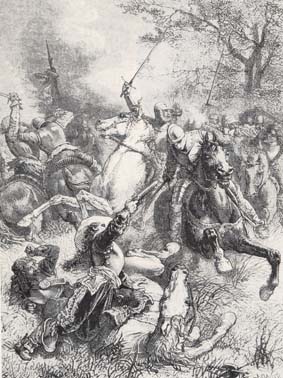 |
| Irish fought in light armor, emphasizing swift strikes over shock tactics. |
The people of Brian, son of Turlough, burned the church of Imlech-Brochadha against the people of O'Flynn, and it full of women, children, and black nuns, and three priests, in it. (Annals of Lough Ce)
AD 1240. Hugh, the son of Gilla-na-naev Crom the Stooped O'Shaughnessy, was slain by Conor, son of Hugh, who was the son of Cathal Crovderg, and by Fiachra O'Flynn. (Annals of the Four Masters)
AD 1241. The Lord Justice, namely, Maurice Fitzgerald, mustered a great army with which he marched into Moynai (Mag nAi) in the county of Roscommon, and plundered Fiachra O'Flynn and Donough Mac Dermot. A small party of O'Conor's people overtook them, and slew Nar Mac Gillakelly, and many others. (Annals of the Four Masters)
AD 1245. Fiachra, the son of David O'Flynn, Chief of Sil-Maelruain, died (Annals of the Four Masters) on Christmas Day (Annals of Lough Ce)
AD 1255. A great depredation was committed by the Foreigners on O'Flynn. (Annals of Lough Ce)
AD 1263. An army was led by Mac William Burke against Felim O'Conor and his
son. He reached Roscommon, and the Sil-Murray fled before him into the
north of Connaught; and the English had no preys to seize upon on that occasion. Donough O'Flynn and Teige, his son, attacked their army, and killed
one hundred of them, noble and plebeian, with Aitin Russell and his son, the
five sons of Cuconnaught O'Conor, and others. The army then returned to
their homes in sorrow.
AD 1266. The borough of Bel-an-tachair [Ballintogher] was burned by Flann Roe O'Flynn, and many of the English of the town were slain by him. (Annals of the Four Masters) Several castles and corn-fields were also burned and destroyed by him in Tir-Fhiachrach. (Annals of Lough Ce)
Note: Roe was a nickname for red-complexion. Since Flann and O'Flynn also mean this, the guy must have been well nigh scarlet!
AD 1271. Donnell O'Flynn was slain by the son of Robin Lawless,
at the upper end of Sruthair. (Annals of the Four Masters)
AD 1284. Simon de Exeter was slain by Brien O'Flynn and the two sons of O'Flanagan, Dermot and Melaghlin; in consequence of which war and dissensions arose in Connaught. After this the English committed great depredations; but they restored the whole of the spoils to the family of Trinity Island and the monks of the abbey of Boyle. (Annals of the Four Masters)
In the same year, Dunmore was burned by Fiachra O'Flynn. (Annals of the Four Masters)
AD 1288. (Magnus O Connor came into Connaught and deposed his older brother, Cathal, and "forcibly assumed the sovreignty.") Turlough son of Owen O Connor, with Malachy O Flannigan,
captured a house from Magnus O Connor this same winter in Ros Mor,
and this was done on the advice of Fiachra O Flainn. Magnus himself was
wounded there; Ragnall Mag Ragnaill, chieftain of the Muinter Eolais,
was killed by a single arrow-shot; Niall Gelbuide O Conchobair was
wounded; some of their men were killed and a part of their good horses
was taken from them. (Annals of Connaught)
AD 1289. Fiachra O'Flynn, Chief of Sil-Maelruain, the most hospitable and expert at arms of all the chiefs of Connaught [when he wasn't advising people on ambushes -- TOF], went to form a marriage alliance with the English, but was treacherously slain by the son of Richard Finn the Fair Mac William Burke, and Mac Feorais Bermingham. (Annals of the Four Masters) In the Annals of Lough Ce, he is described as "...the most clement, truthful, protecting, hospitable, and valorous man of all the chieftains of Connacht..." [and all-around Mr. Nice Guy -- TOF]
AD 1284. Simon de Exeter was slain by Brien O'Flynn and the two sons of O'Flanagan, Dermot and Melaghlin; in consequence of which war and dissensions arose in Connaught. After this the English committed great depredations; but they restored the whole of the spoils to the family of Trinity Island and the monks of the abbey of Boyle. (Annals of the Four Masters)
In the same year, Dunmore was burned by Fiachra O'Flynn. (Annals of the Four Masters)
Dunmore, last seen burned by the Munstermen in AD 1134. is just south of the Sil Maelruain, in Galway. The name Dun Mor means "Big Fort."
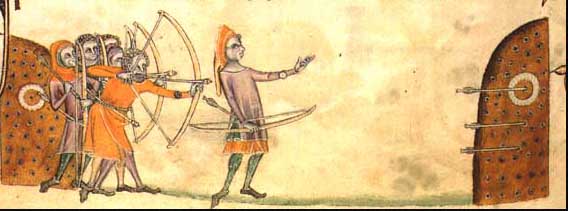 |
| Medieval Ireland was the heyday of war archery |
AD 1289. Fiachra O'Flynn, Chief of Sil-Maelruain, the most hospitable and expert at arms of all the chiefs of Connaught [when he wasn't advising people on ambushes -- TOF], went to form a marriage alliance with the English, but was treacherously slain by the son of Richard Finn the Fair Mac William Burke, and Mac Feorais Bermingham. (Annals of the Four Masters) In the Annals of Lough Ce, he is described as "...the most clement, truthful, protecting, hospitable, and valorous man of all the chieftains of Connacht..." [and all-around Mr. Nice Guy -- TOF]
Keep an eye on Bermingham.AD 1300. Seoinin Oge Mac Maurice (Johnny Prendergast) was slain with many of his men by Conor, the son of Fiachra O'Flynn. (Annals of Connaught) [Mac Muiris was a branch of the Prendergasts in Co. Mayo. Had he also been involved along with Bermingham and MacWilliam Burke in the ambush of Conor's father?]
AD 1305 Sir Piers Mac Feorais Bermingham, having agreed to act as god-father to his nephew, Mutough O'Conor Faly, his brother and all the O’Conor Faly chiefs attended a baptismal mass with the Berminghams at Carrick, Co. Kildare on the feast of the Holy Trinity. After the mass the whole party entered the Bermingham Castle at Carrick and it was here that Birmingham's men attacked and killed Murtough and his entire family. Twenty-nine people are said to have been killed and then decapitated. The child was "thrown from the battlements". "In Gaillsech Shacsanach (the wife of Piers) shouted from the top of the castle regarding any she spotted who went into hiding, so that many were slain as a result of those warnings. And woe to the Gaedel who puts trust in a king’s peace or in foreigners after that! For, although they had their king’s peace, their heads were brought to Áth Cliath [Dublin], and much wealth was obtained for them from the foreigners. (Annals of Inisfallen)
That is, far from being punished for the act of treachery, MacFeorais Berminham was paid a bounty for the heads he delivered to the Justiciar’s Court at Naas. Was he paid a similar bounty for slaying Fiachra O Flynn sixteen years earlier? Last act to follow soon.
Any resemblance to the Red Wedding in the Game of Thrones series is.... probably deliberate.
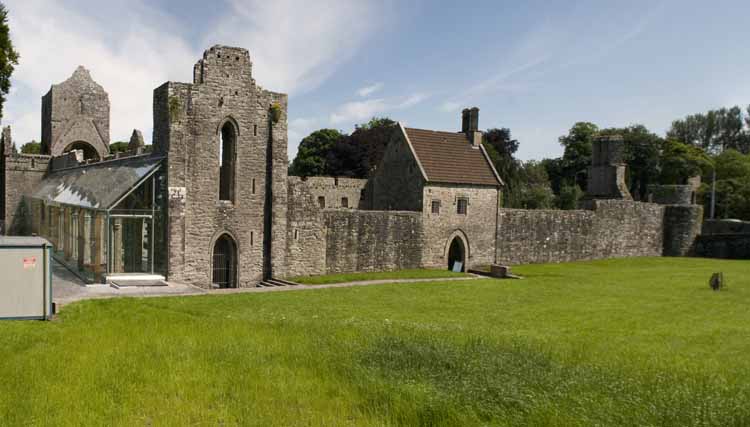 |
| Remains of the Monastery of Boyle. Conor and Flann were buried here, and probably earlier chiefs, like David, as well. |
AD 1309. Hugh, the son of Owen, son of Rory, son of Hugh, son of Cathal Crovderg, King of Connaught, and worthy heir to the monarchy of Ireland, the most hospitable and expert at arms of all the Irish born in his time, was slain by Hugh Breifneach, the son of Cathal O'Conor, at Coill-an-clochain, together with many of the chiefs of his people about him. Among these were Conor Mac Dermot; Dermot Roe, son of Teige O'Conor; Dermot, son of Cathal Carragh Mac Dermot; Hugh, son of Murtough, son of Teige, son of Mulrony; and Dermot O'Healy, a princely brughaidh, the best of his time. On the other side fell Gilla-na-naev Mac Egan, Chief Brehon of Connaught, and the most illustrious of the Brehons of his time; Faghartach O'Devlin, and others not mentioned. The Sil-Murray then conferred the lordship upon Rory,the son of Cathal O'Conor. Afterward, Rory O'Conor and O'Flynn led a troop of cavalry to the Plain [Mag nAi], and slew Mac Feorais Bermingham. (Annals of the Four Masters)
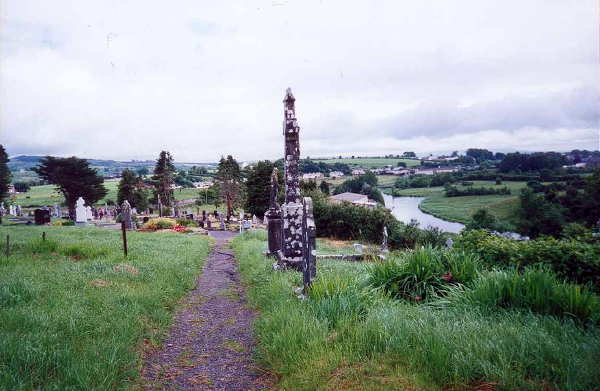 |
| Assylinn cemetery. The Church of Ess
Dachonna was in the area. The Cataract is said to be much worn down today. |
Revenge for the murder of Fiachra in 1289 and of the O'Conor Faly clan in 1306!
AD 1315. "Edward son of Robert Bruce, Earl of Carrick, came from Scotland to Ireland, landing on the coast of North Ulster with the men of three hundred ships, and his warlike slaughtering army caused the whole of Ireland to tremble, both Gael and Gall." Richard Burke, the Red Earl, raised an army against him that included Felim O'Conner, king of Connaught. But Edward cut a deal with Felim. Meanwhile, Rory son of Cathal Roe O Conner, on seeing Connaught left unguarded, went to speak with Edward, and offered to drive the Normans from Connaught for him. And Edward agreed, provided that he did not attack Felim's territory. Instead, Rory assembled an army and burned the town of Sligo, Ballymote, the great castle of Kilcolman, Ballintober, Dunamon with its castle, Roscommon, Randoon and Athlone, as well as all the houses which lay on his route. He camped at Bally mor O Floinn and profaned the church of Ess Dachonna. [This was Assylinn or O Flynn's Cataract.] (Annals of Connaught and Annals of the Four Masters)
AD 1331. Thomas, the son of Cuchairrge O'Flynn, died. (Annals of the Four Masters)
AD 1341. Brian O'Flynn, Lord of Teallach-Curnain, died. (Annals of the Four Masters)
AD 1368. Fiachra O'Flynn, heir to Sil-Maelruain, the best man of his tribe in his time, died; and his wife died also. (Annals of the Four Masters)
AD 1383. Miles Mac Costello was slain by the sons of Fiachra O'Flynn. (Annals of the Four Masters)
AD 1413. O'Flynn, Chief of Sil-Maelruain*, was slain by the son of Murtough O'Flynn. (Annals of the Four Masters) and some of the Clan Conway. (Annals of Connaught) *The annals of Connaught call him "chieftain of Tellach Curnan."
AD 1443. O'Flynn of Sil-Maelruain and some of his kindred were slain by the Clann-Costello at the house of O'Killeen.. (Annals of the Four Masters)
AD 1464. O'Flynn, that is the lord of Sil Mailruain, and his brother Gilla na Naem O'Flynn were killed by the posterity of Philip McCostello at Cluain Cruimm and five of their people were killed with them. (Annals of Connaught)
AD 1469. O'Flynn, Lord of Sil-Maelruain, and his brother, were slain by Melaghlin [Malachy] O'Flynn, who afterwards assumed the lordship (Annals of the Four Masters)
AD 1473. Brian the Short O'Flynn was killed by his own people. (Annals of Connaught)
The Arms of the O'Flynns of Connaught.The Flynns in the Early Modern Age
It is not known when the Irish clans began to adopt the Norman custom of coats of arms, but it was probably before this point. The Flynn arms are usually given as a wolf below three bezants, and it is well-nigh impossible to find any other. However, there were three unrelated Flynn clans in Ireland, and the familiar arms are those which O'Hart's Irish Pedigrees and Burke's General Armory describes for the Flynns of Munster. For the Flynns of Connaught he blazons: "Argent a dexter arm couped between two swords in pale all proper." This would be a silver shield with a right arm cut off (probably at the elbow) flanked by two swords (all pointing up) in the middle third of the shield, everything in its proper color. (O'Hart's Irish Pedigrees and Burke's General Armory) I have never seen a visual representation of these arms and nowadays, all the Flynns seem to use the arms of the Flynns of the South rather than the Flynns of the West.
AD 1585. The Composition of Connaught. Agents of Queen Elizabeth parceled out Connaught into Counties and Baronies. The Irish lords were reinstated as English vassals, provided they surrendered their rights, titles and usages as Irish clan chiefs. Among those listed in the Indenture of Maghery Connaught for "the Contries or territories of Moylorug alias mc Dermots Contry, O Connor roes Contry and O Connor donnes Contry" are "feegh o flyn of Sleavlin chiefe of his name" and "Collo o flyn of the cladagh gen." That would be Fiachra O'Flynn of O'Flynn's Mountain (i.e., Ballinlough) and Columb O'Flynn of Assylinn, gentleman. It was agreed ("condiscnded granted promised and agreed") that the O Flyne would continue to possess "not only such castles and landes as belongeth to the name and calling of O flynne, but also such castles and landes as they may be now justly seized of" the same to pass from father to son according to the English manner. However, neither Fiachra nor Columb signed the indenture. (The Compossicion Booke of Conought)
The O'Flynns were one of the last if not the last to reject having to pay rent on their lands to the crown. They paid the price and were eventually put out of their possessions both castle and lands. This fate would be sealed when Cromwell passed through Ballinlough in the late 1640's and any sign of resistance was put down by the sword.
AD 1586. Thomas, son of O'Flynn was was hanged in Ros-comain two days before the festival of St. Catherine. Perhaps as a consequence of his father not signing the indenture.
AD 1595. The Nine Years War began with the rebellion of O'Neill and O'Donnell in Ulster.
AD 1597. The heir of O'Flynn et al. were pledged as hostages by Hugh McDermot O Conner Don to the O Donnell as a guarantee of his loyalty.
AD 1602. The March of O'Sullivan Beare. In January, the Nine Years War came to an end with the defeat of the Irish and Spanish by the English at Kinsale. This resulted in the Flight of the Earls (O'Neill and O'Donnell). One of the holdouts was the O'Sullivan Beare, Donal Cam (right), who in 1603 gathered his remaining followers, including women and children, and set off for the North, on a 250-mile march which he and his people completed in 14 days. He fought a long rearguard action across Ireland, during which the much larger English force harried him all the way -- as did rival Irish leaders. The march is one of the most poignant in Irish history and was marked by enormous suffering as the fleeing and starving O'Sullivans sought food from an already decimated Irish countryside in winter, often resulting in hostility, such as from the Mac Egans at Redwood Castle in Tipperary. O'Sullivan marched through Aughrim in Co. Galway, where he raided villages for food and met with local resistance. He fought a skirmish with crown forces at Glinsk Castle, where he was victorious, and led his refugees further north. This brought him into the Sil Maelruain.
O'Sullivan's route through O'Flynn country is well authenticated and must have been facilitated by O'Flynn guides. How else could complete strangers find their way safely through water logged marshes and rugged mountains in mid winter without local help? He made his escape across Ballymoe and over O'Flynn's Mountain, avoiding the village of Ballinlough. He camped over-night in the woods north of the village where he was befriended by the O'Flynns from their castle on the hill. Such befriending would not have been seen in a favourable light by the pursuing forces of the crown and O'Flynn would not have done himself any favours in their eyes. There is a tradition that many of O'Sullivan Beare's followers dropped off here and there on the route and settled in friendly places. There is evidence of this locally with names such as Carty, McCarthy and O'Callaghan who can trace their roots back to that time. When they finally arrived at the O'Rourke's castle in Leitrim, only 35 of the original 1,000 remained. (Clan: O'Flynn, The Beara-Breifne Greenway)
Survey and Distribution of Roscommon
AD 1649. Cromwell's Commonwealth. Parliamentary troops landed in Ireland and begin three years of war against an alliance of Catholic Confederates and English Royalists, including Protestant Royalists. Cromwell eventually convinced the Protestant Royalists to switch sides.
AD 1650. An Order in Council was issued for "the apprehension of the person of Fegheraugh O'Flynn [Fiachra O'Flynn of Ballinlough] and other Confederates fighting against the Commonwealth. He was considered armed and dangerous. This Fiachra was the chief of the name at the time and is listed in the Book of Survey and Distribution for County Roscommon as holding lands around Ballinlough, Parish Killalagh, Barony of Balintobber.
AD 1652. After a series of sieges and massacres, the last Catholic-held town, Galway, surrendered in April 1652. Among those refusing to sign the surrender was one Richard Flynne. (History of the Town and County of Galway). The last Irish troops capitulated in April of the following year. Dudly Flynn of Ballintobber took the oath of allegiance to Cromwell's Commonwealth. (O'Hart's Irish Pedigrees)
Act for the Settlement of Ireland. All Catholic-owned land was confiscated and given to Scottish and English settlers, the Parliament's financial creditors and Parliamentary soldiers. The remaining Catholic landowners were allocated poorer land in the province of Connacht (They were to be sent "to hell or to Connacht"). Catholic landownership dropped from 60% of the total to just 8%. The public practice of Catholicism was banned and Catholic priests were murdered when captured. (Wikipedia)
Most of the land belonging to the Confederate, Fiachra O'Flynn, was given to Columb O'Flynn, perhaps a son or other close relative. (Book of Survey and Distribution: Roscommon). There are numerous other Flynns listed in the Distribution in Kiltullagh and Kilkeevin parishes under variations of the name: incl. Flynn, Flyn, Flin, Fflenn, and Fflinn, with two f's, with and without capitalization, with and without the O! Chief among them are:
- Feoghra of Ballinlough,
- Columb,
- Laughlin, and
- Callough husband to Onora Flin. Onora is the only woman listed and may have been a widow of the said Callough.
Ballintobber Barony, Killtullogh Parish
4. Feaghra Flinn (proprietor in 1641)
Ballinlogh, a townland being 4 Qtrs, viz., Ballinlogh, Cloonilagh, Owre, ½ qtr Cloneleofe, and ½ qtr Cloonisklan: arable and woody and moorish pasture intermixt. 190 acres unprofitable; 573 acres profitable
A pasturable Wood and woody Ground 101 acres; 202 acres
of high Course Mountain with some few spots of Wood on ye same: 850 acres; 83 acres
A logh lying within ye Lands of Ballinlough: 272 acres
The profitable acres were distributed after 1652 to: A pasturable Wood and woody Ground 101 acres; 202 acres
of high Course Mountain with some few spots of Wood on ye same: 850 acres; 83 acres
A logh lying within ye Lands of Ballinlough: 272 acres
Edward Birmingham(!) (105), Dominick Meade (6), Daniell Coffey (79), Richard Martin (32), Collumb fflynn
(164+82+82), Roger mcDermott (105), Peirce Dillon (16), John Eyres,
esq. (108), Calla mcc Keogh (48), Morrish Conry (61), John Browne (48),
ffergus Kelly (187)
AD 1653/4. From the list of Connaught Transplantees:
- Dudly Flynn,
- Collum Flynn,
- Feaghra FLynn,
- Laughlin Flynn
AD 1659. In the Barony of Ballintobber, there were 29 Flynn households, of which five were listed as landholders:
- Feoghra Flinn Esq. of Ballinlagh, Killalagh;
- John Flinn Gent. of Clooneacrew, Killalagh;
- Gilternew Flinn Gent. of Clooneraghan, Kilkeevin;
- Dudley Flinn Gent. of Cloonesallagh, Kilkeevin; and
- Roger Flinn Gent. of Ballemageher, Ballintobber.
AD 1660. Among the gentry restored under Charles II: Charles O Flyne of Celtabar, Co. Roscommon. (O'Hart's Irish Pedigrees)
AD 1688. The Glorious Revolution overthrew the Stuart kings of Great Britain for being Catholic. The following year, the Stuarts invaded Ireland to popular support, but were defeated at the Battle of the Boyne.
AD 1690. Feaghra macColumb Flynn was outlawed in abstentia for "Stuartism" and became one of the Wild Geese. The Irish Brigade fought in the French Army and was the ancestor of the French Foreign Legion. Their descendants included Patrice de Mac-Mahon (Marshal of France and first president of the Third Republic) and Maximilian Karl Lamoral Graf O’Donnell von Tyrconnell (Austrian officer and civil servant who became famous when he saved the life of the Emperor Franz Josef I.) Among the retinue of James II: Mau(rice?) Flynn. (O'Hart's Irish Pedigrees)
AD 1696. The Inquisitions of 1696 mentioned Fiachra O'Flynn of Ballinlough as head of the family.
AD 1703. As a result of the Stuart uprising and the subsequent Inquisitions, Joseph Mitchell and John Trench of Dublin received lands in the Barony of Ballintubber which had belonged to Fiachra O'Flynn, who had been attainted, i.e. dispossessed and condemned to death, probably for refusing to bend to crown demands. (Clan: O'Flynn, The Beara-Breifne Greenway) The Book of Survey and Distribution includes these dispositions as add-ons, where we find that 1407 acres around Ballinlough were sold to Joseph Mitchell.
AD 1768. David Flynn, a descendant of the Ó Floinn of Síol Maelruain, had been born in County Galway and educated in Paris, graduating from the Sorbonne. A Dominican, he was appointed chaplain to James Francis Edward Stuart, the Old Pretender a/k/a "James III", at Saint-Germain-en-Laye. In 1768, Bishop O'Brien stated of his family that:
"The O'Flynns' present chief is Edmond O'Flinn of Ballinlough. The Right Hon. Lady Ellen O'Flinn, Countess de la Hues of Lahnes Castle in Normandy, is of the same direct branch of the O'Flinns, her ladyship being a daughter of Timothy O'Flinn of Clydagh in Co. Roscommon."In 1770, he died at Saint-Germain-en-Laye, and was buried in the crypt of the parish church. He was attended at his funeral by two nephews, Dr. Charles O'Flynn and Father Jean Evrines.
The Leaving of Ballinlough
Correspondence with Flynns from Loughrea a number of years ago established that they had come there from Roscommon. The daughter of one John Flynn of Ballinlough wrote that "after the Cromwell war," a Flynn widow, told she would have to pay rent to the English landlord from now on, said she would do no such thing, and took her family to live with her relatives in Loughrea, Co. Galway. It was said, but not certainly, that she was a Burke. Perhaps it was that Onora Flynn mentioned in the Book of Survey and Distribution. In any case, the probability is high that TOF is descended from a stubborn old lady.
This branch of the Flynns left the Ballinlough region probably in 1652, but surely no later than 1703.
Next: The Flynns of Loughrea
On-Line References
O'Hart's Irish Pedigrees: This should link you to the index page where O'Flynn appears. Note that it is O'Flynn of Connaught that matters to us, not the other, unrelated Flynns.
Annals of the Four Masters: additional sections can be accessed by changing the url; e.g., change T100005C/text001 to T100005C/text002 or to T100005D/text001, etc. The letters are a block of texts, so it runs 5A/text 1, 2, 3... the 5B/text 1, 2, 3... etc. The text uses "O'Flynn."
Annals of Connaught: additional sections can be accessed by clicking on the years to the left; then for a new file, changing the number in the url; e.g., T100011 to T100010 or T100012 The text uses "O Flainn" with no apostrophe.
Annals of Lough Ce: additional sections can be accessed by clicking on the years to the left, then for a new file changing the letter in the url; e.g., T100010B to T100010A or T100010C The text uses "O'Floinn."
The March of O'Sullivan Beare: by the Tourist Board of Ireland
Mount, Charles. "The O’Conor Faly Murders of 1306" (Dr. Charles Mount, 29/09/2011)
David Flynn (chaplain) Wikipedia.
Off-Line References
The Composition Book of Connaught (1585)
The Book of Survey and Distribution, Co. Roscommon (1641 and 1703)
The Topography of Ireland
The Connaught Tribune: photocopy of an article regarding the Flynns of Roscommon




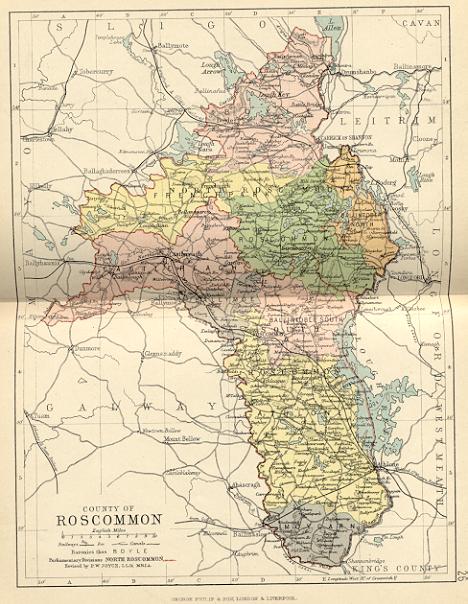

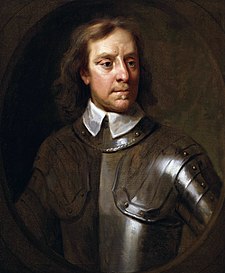
.jpg)


Looks like the O'Flynns had a pretty rough time of it.
ReplyDeleteWere any of your ancestors Deryni? (Katherine Kurtz' DERYNI books...) The books and your real history sound SO COOL...
ReplyDeleteMost Irish clans have eventful histories full of brave men and women (yay!), saints (yay!), and totally shady ruffians and traitors (boo!). A lot of primary and secondary sources are now available online, and Google Maps joined with the old maps online can allow you to cruise around your clan territory virtually.
ReplyDeleteThe other important appearance of O'Flynn's Mountain is in the very famous song "The Brown Blackthorn Tree" ("An Droighneán Donn," "An Draighneán Donn," or "An Drinaun Dun," depending on your spelling preference), where we learn that
"Sneachta séidte agus é dá shíor-chur ar Shliabh Uí Fhloinn,
Tá mo ghrá-sa mar bhláth na n-airní bíos ar a' Droighneán Donn."
Soft blowing snow, and it falling constantly on O'Flynn's Mountain,
My love is like the [white] blossom on the brown blackthorn.
The other name for blackthorn is "sloe," and here's a picture of the flowers.
The interesting thing is that the most common _English_ set of lyrics is all about summer and the sun shining on wildflowers, rather than snow! Also, one version is sung from the woman's point of view, one version is from the faithless man's, and one version is a sort of dialogue. Joe Heaney had a story to go with it.
Here's a page with recordings and transcriptions of various versions of the song, along with other Gaelic songs sung in Ulster. You usually hear more the Southern/Munster version of this song, although the Northern lyrics are more common in print.
The St. Dachona or Dachonna mentioned here is a guy, and his feastday is March 8. Most sources have him as a son of Echaid son of Illand son of Eogan, but O'Donovan has him as a son of Erc. He was sent out there by St. Columcille.
ReplyDeleteThere's another St. Dachona or Dachona, which is the nickname version of Conaine, and she was a woman who was a big saint for the O'Connors. She was a half-sister of St. Senan, on his mother's side.
The current name Dachon or DaChon is apparently a variant spelling of DaShawn and similar names.
I have been researching the O'Flyn's and would like to make contact directly with the author
ReplyDeleteMy email smarterfones@yahoo.ie
Patrick O'Flynn
Ursula Lynn here, born Ballycastle 1964. Grandfather William lynn
ReplyDeleteI'm a decendant of the o'flynns of balinlough my great grandmother was o'flynn and I live very close to balinlough now. At least we never gave up and never recognised the English unlike the turn coats of our own country men!!
ReplyDelete